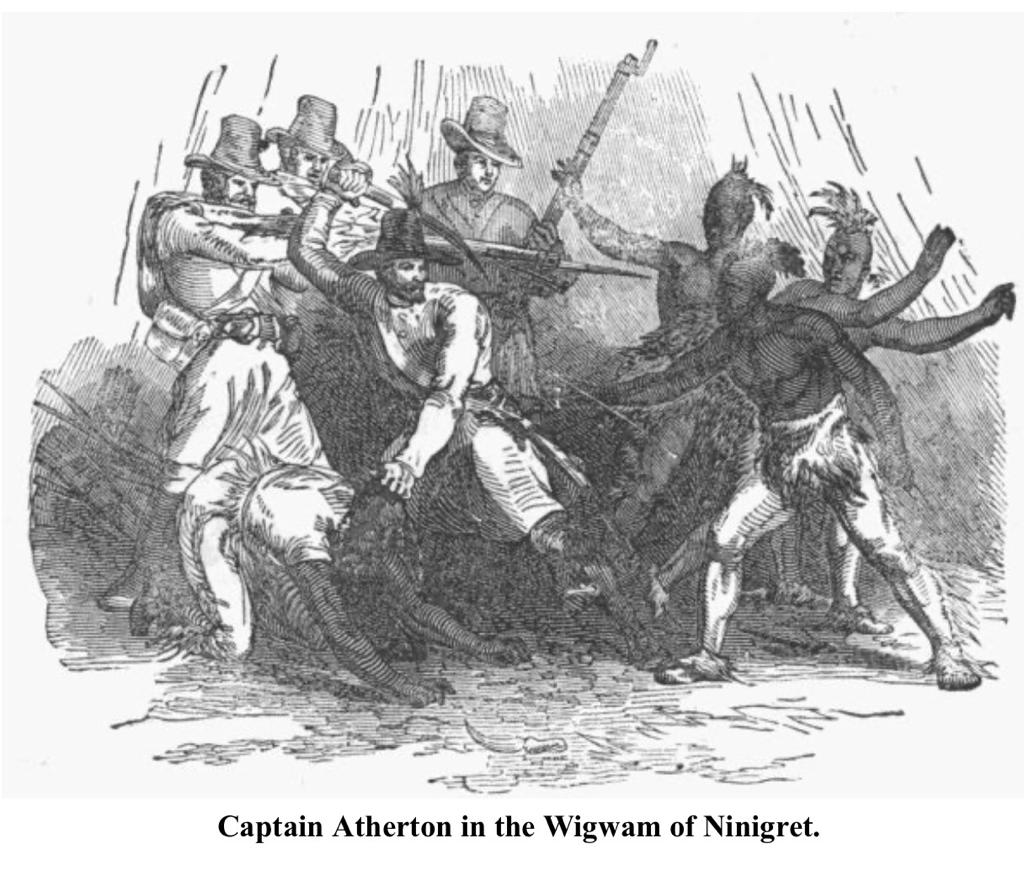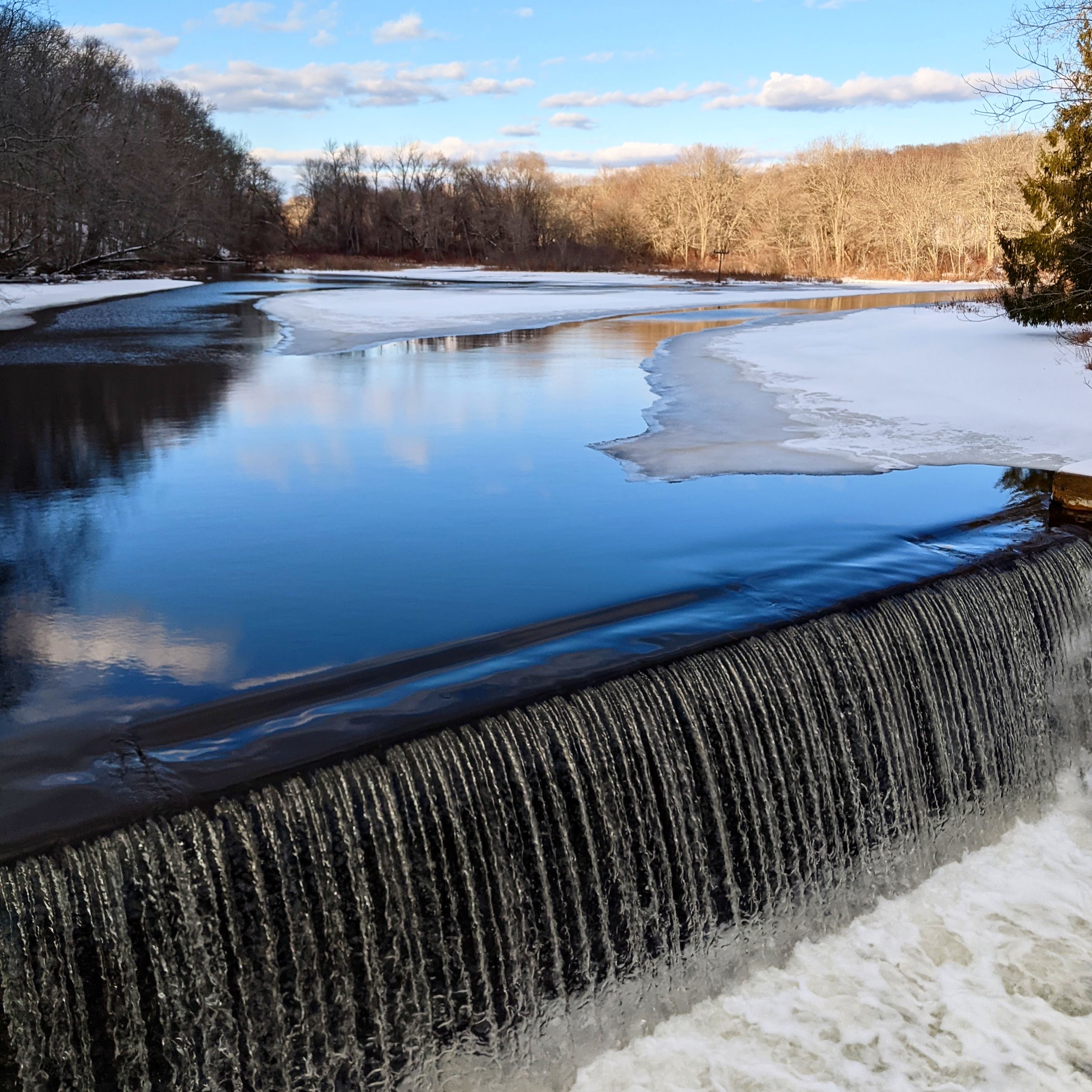|
Niantic People
The Niantic (Nehântick or Nehantucket in their own language) were a tribe of Algonquian-speaking American Indians who lived in the area of Connecticut and Rhode Island during the early colonial period. They were divided into eastern and western groups due to intrusions by the more numerous and powerful Pequots. The Western Niantics were subject to the Pequots and lived just east of the mouth of the Connecticut River, while the Eastern Niantics became very close allies to the Narragansetts. It is likely that the name Nantucket is derived from the tribe's endonym, Nehantucket. The division of the Niantics became so great that the language of the eastern Niantics is classified as a dialect of Narragansett, while the language of the western Niantics is classified as Mohegan-Pequot. History The Niantics spoke an Algonquian Y-dialect similar to their neighbors the Pequots, Mohegans, and Narragansetts in New England, and the Montauks on eastern Long Island. The tribe's name "Neh ... [...More Info...] [...Related Items...] OR: [Wikipedia] [Google] [Baidu] |
Tribal Territories Southern New England
The term tribe is used in many different contexts to refer to a category of human social group. The predominant worldwide usage of the term in English is in the discipline of anthropology. This definition is contested, in part due to conflicting theoretical understandings of social and kinship structures, and also reflecting the problematic application of this concept to extremely diverse human societies. The concept is often contrasted by anthropologists with other social and kinship groups, being hierarchically larger than a lineage or clan, but smaller than a chiefdom, nation or state. These terms are equally disputed. In some cases tribes have legal recognition and some degree of political autonomy from national or federal government, but this legalistic usage of the term may conflict with anthropological definitions. In the United States, Native American tribes are legally considered to have "domestic dependent nation" status within the territorial United States, wit ... [...More Info...] [...Related Items...] OR: [Wikipedia] [Google] [Baidu] |
Ninigret
Ninigret (also known as Juanemo according to Roger Williams) (c. 1610 This source confirms 1662 as the date of his land sales.-1677 This source suggests a date of 1667 for his land sales and a 1647 war against the Mohegans.) was a sachem of the eastern Niantic Indian tribe in New England at the time of colonization, based in Rhode Island. In 1637, he allied with the colonists and the Narragansetts against the Pequot Indians. Ninigret is credited with keeping the Niantics out of King Philip's War, in which the colonists fought to prevent their homes and settlements from being destroyed by certain Indian tribes. Biography Ninigret was the son of Sachem Saccious, the cousin or the uncle of Miantonomo, and the uncle and brother-in-law of Harman Garrett. He was first known to the colonists as Janemo and was sachem of the Niantics, a tribe of the Narragansett people. He did not participate in the Pequot war of 1632, and he aided the colonists in the Pequot war of 1637. About a year af ... [...More Info...] [...Related Items...] OR: [Wikipedia] [Google] [Baidu] |
Culture Of New England
The culture of New England comprises a shared heritage and culture primarily shaped by its indigenous peoples, early English colonists, and waves of immigration from Europe, Asia, Africa, and the Americas. In contrast to other American regions, most of New England's earliest Puritan settlers came from eastern England, contributing to New England's distinctive accents, foods, customs, and social structures. Overview New England is the oldest region of the United States and one of the first successful English settlements in the Americas, and it has a long and oft-contested cultural history. Professor of American and New England Studies Joseph A. Conforti writes, "New England has been a storied place. Its identity has been encoded in narratives about its past—stories that have been continually revised in response to new interpretive needs generated by the transformations of regional life helpingNew Englanders negotiate, traditionalize, and resist change." As such, New England cu ... [...More Info...] [...Related Items...] OR: [Wikipedia] [Google] [Baidu] |
Yankee
The term ''Yankee'' and its contracted form ''Yank'' have several interrelated meanings, all referring to people from the United States. Its various senses depend on the context, and may refer to New Englanders, residents of the Northern United States, or Americans in general. According to the ''Oxford English Dictionary'', it is "a nickname for a native or inhabitant of New England, or, more widely, of the northern States generally". Outside the United States, ''Yank'' is used informally to refer to an American person or thing. It has been especially popular in the United Kingdom, Ireland, Canada, South Africa, Australia, and New Zealand where it may be used variously with uncomplimentary overtones or cordially. In the Southern United States, ''Yankee'' is a derisive term which refers to all Northerners, and during the American Civil War was applied by Confederates to soldiers of the Union army in general. Elsewhere in the United States, it largely refers to people from the Nort ... [...More Info...] [...Related Items...] OR: [Wikipedia] [Google] [Baidu] |
Kickapoo People
The Kickapoo people ( Kickapoo: ''Kiikaapoa'' or ''Kiikaapoi''; es, Kikapú) are an Algonquian-speaking Native American and Indigenous Mexican tribe, originating in the region south of the Great Lakes. Today, three federally recognized Kickapoo tribes are in the United States: the Kickapoo Tribe in Kansas, the Kickapoo Tribe of Oklahoma, and the Kickapoo Traditional Tribe of Texas. The Oklahoma and Texas bands are politically associated with each other. The Kickapoo in Kansas came from a relocation from southern Missouri in 1832 as a land exchange from their reserve there. Around 3,000 people are enrolled tribal members. Another band, the Tribu Kikapú, resides in Múzquiz Municipality in the northern Mexican state of Coahuila. Smaller bands live in Sonora, to the west, and Durango, to the southwest. Name and etymology According to some sources, the name "Kickapoo" (''Giiwigaabaw'' in the Anishinaabe language and its Kickapoo cognate ''Kiwikapawa'') means "stands here a ... [...More Info...] [...Related Items...] OR: [Wikipedia] [Google] [Baidu] |
Wigwam
A wigwam, wickiup, wetu (Wampanoag), or wiigiwaam (Ojibwe, in syllabics: ) is a semi-permanent domed dwelling formerly used by certain Native American tribes and First Nations people and still used for ceremonial events. The term ''wickiup'' is generally used to refer to these kinds of dwellings in the Southwestern United States and Western United States and Northwest Alberta, Canada, while ''wigwam'' is usually applied to these structures in the Northeastern United States as well as Ontario and Quebec in central Canada Central Canada (french: Centre du Canada, sometimes the Central provinces) is a region consisting of Canada's two largest and most populous provinces: Ontario and Quebec. Geographically, they are not at the centre of Canada but instead overlap w .... The names can refer to many distinct types of Indigenous structures regardless of location or cultural group. The wigwam is not to be confused with the Native Plains tipi, which has a different construction, ... [...More Info...] [...Related Items...] OR: [Wikipedia] [Google] [Baidu] |
Ezra Stiles
Ezra Stiles ( – May 12, 1795) was an American educator, academic, Congregationalist minister, theologian, and author. He is noted as the seventh president of Yale College (1778–1795) and one of the founders of Brown University. According to religious historian Timothy L. Hall, Stiles' tenure at Yale distinguishes him as "one of the first great American college presidents." Early life Adolescence and education Ezra Stiles was born on in North Haven, Connecticut, to Rev. Isaac Stiles and Kezia Taylor Stiles (1702–1727). His maternal grandfather, Edward Taylor had emigrated to Colonial America from Leicestershire, England, in 1668. Kezia Taylor Stiles died four days after giving birth to Ezra. Stiles received his early education at home and matriculated at Yale College in September 1742, as one of 13 members of the college's freshman class. At Yale, he studied a liberal arts curriculum characterized by an uncertain period of transition between moribund Puritan thoug ... [...More Info...] [...Related Items...] OR: [Wikipedia] [Google] [Baidu] |
East Lyme, Connecticut
East Lyme is a town in New London County, Connecticut, United States. The population was 18,693 at the 2020 census. The villages of Niantic and Flanders are located in the town. Geography East Lyme is located in southern New London County, west of Waterford and Montville, east of Lyme and Old Lyme, and south of Salem. Long Island Sound is to the south. According to the United States Census Bureau, the town has a total area of , of which is land and , or 19%, is water. Villages The town consists primarily of two villages, Flanders and Niantic. It is common for the town of East Lyme to be erroneously called "Niantic", due to this side of town being the "beach" side which is popular with tourists and visitors in the summer months. Niantic's population doubles in the summer months for the beach season, and it has a much higher density than the more sparsely populated Flanders side of town, which is known for its apple orchards, the town's high school, and the forest. Niantic ... [...More Info...] [...Related Items...] OR: [Wikipedia] [Google] [Baidu] |
Woodstock, Connecticut
Woodstock is a town in Windham County, Connecticut, United States. The population was 8,221 at the 2020 census. History 17th century In the mid-17th century, John Eliot, a Puritan missionary to the Native Americans, established "praying towns" where Native Americans took up Christianity and were expected to renounce their religious ceremonies, traditional dress, and customs. One Praying town, called Wabaquasset (Senexet, Wabiquisset), six miles west of the Quinebaug River in present-day Woodstock, was the largest of the three northeastern Connecticut praying towns. In 1675, when King Philip's War broke out, some of the town's Indians, (especially in the southern part of the town) sided with the Mohegans and the English while others sided with the Indians led by Philip, rallying to arms on what is now Curtis Island in present Holland, Massachusetts and Brimfield, Massachusetts. During the war, the Praying town became deserted, and the English with their Indian allies marched t ... [...More Info...] [...Related Items...] OR: [Wikipedia] [Google] [Baidu] |
Narragansett (tribe)
The Narragansett people are an Algonquian American Indian tribe from Rhode Island. Today, Narragansett people are enrolled in the federally recognized Narragansett Indian Tribe. They gained federal recognition in 1983. The tribe was nearly landless for most of the 20th century but acquired land in 1991 in their lawsuit ''Carcieri v. Salazar'', and they petitioned the Department of the Interior to take the land into trust on their behalf. This would have made the newly acquired land to be officially recognized as part of the Narragansett Indian reservation, taking it out from under Rhode Island's legal authority. In 2009, the United States Supreme Court ruled against the request, declaring that tribes which had achieved federal recognition since the 1934 Indian Reorganization Act did not have standing to have newly acquired lands taken into federal trust and removed from state control. Reservation The Narragansett tribe was recognized by the federal government in 1983 and contro ... [...More Info...] [...Related Items...] OR: [Wikipedia] [Google] [Baidu] |
King Philip's War
King Philip's War (sometimes called the First Indian War, Metacom's War, Metacomet's War, Pometacomet's Rebellion, or Metacom's Rebellion) was an armed conflict in 1675–1676 between indigenous inhabitants of New England and New England colonists and their indigenous allies. The war is named for Metacomet, Metacom, the Wampanoag people, Wampanoag chief who adopted the name Philip because of the friendly relations between his father Massasoit and the Pilgrims (Plymouth Colony), ''Mayflower'' Pilgrims. The war continued in the most northern reaches of New England until the signing of the Treaty of Casco (1678), Treaty of Casco Bay on April 12, 1678. Massasoit had maintained a long-standing alliance with the colonists. Metacom (), his younger son, became tribal chief in 1662 after Massasoit's death. Metacom, however, forsook his father's alliance between the Wampanoags and the colonists after repeated violations by the colonists. The colonists insisted that the 1671 peace agree ... [...More Info...] [...Related Items...] OR: [Wikipedia] [Google] [Baidu] |
Lyme, Connecticut
Lyme is a New England town, town in New London County, Connecticut, New London County, Connecticut, United States, situated on the eastern side of the Connecticut River. The population was 2,352 at the 2020 United States Census, 2020 census. Lyme is the eponym of Lyme disease. History In February 1665, the portion of the territory of the Saybrook Colony east of the Connecticut River was set off as the plantation of East Saybrook, which included present-day Lyme, Old Lyme, Connecticut, Old Lyme, and the western part of East Lyme, Connecticut, East Lyme. In 1667, the Connecticut General Court formally recognized the East Saybrook plantation as the town of Lyme, named after Lyme Regis, a coastal town in the south of England. The eastern portion of Lyme (bordering the town of Waterford, Connecticut, Waterford) separated from Lyme in 1823 and became part of East Lyme. The southern portion of Lyme (along Long Island Sound) separated in 1855 as South Lyme (renamed Old Lyme in 1857). Both ... [...More Info...] [...Related Items...] OR: [Wikipedia] [Google] [Baidu] |










